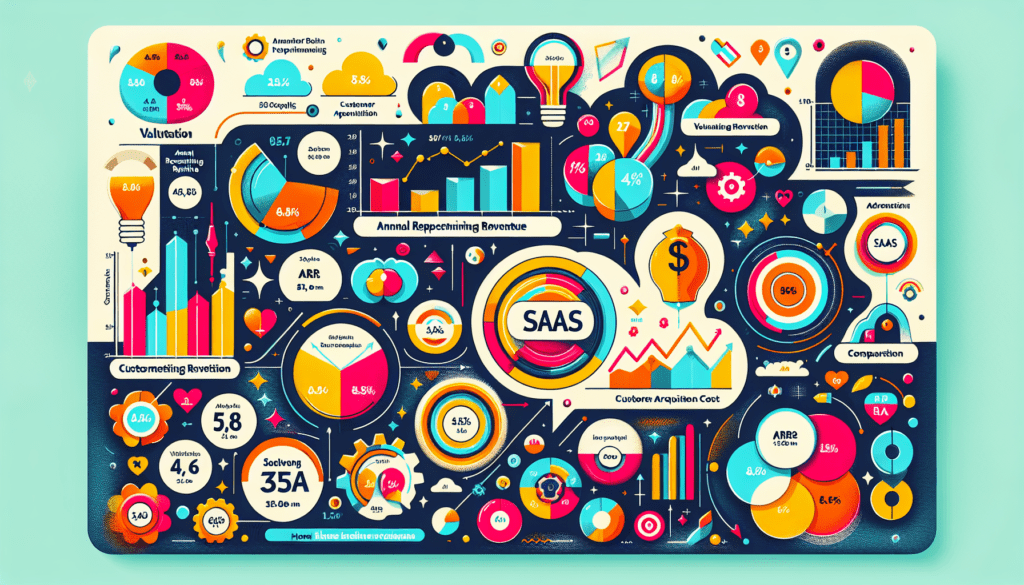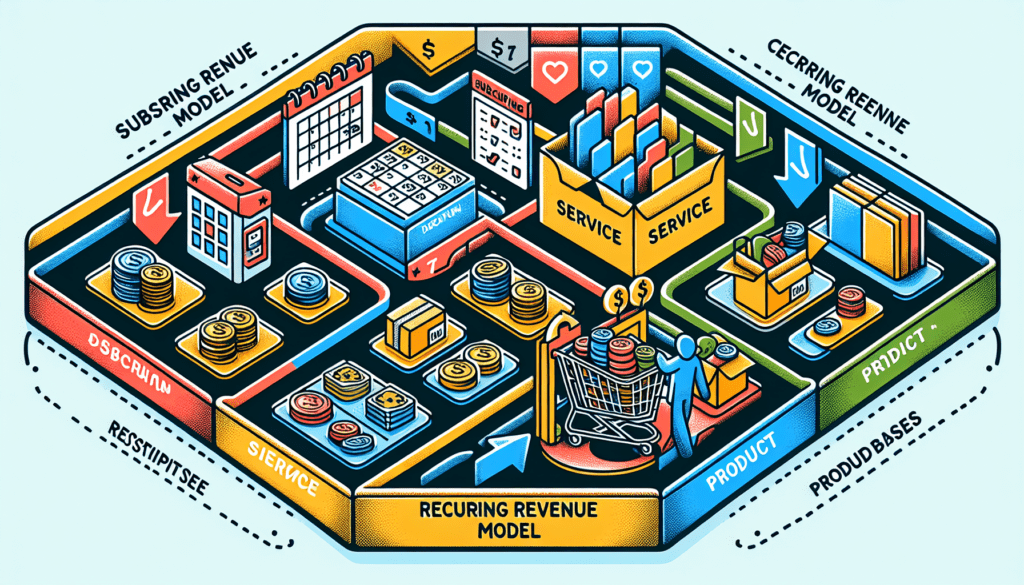Creating Recurring Revenue Increases Your Company’s Value

Are you wondering how to achieve higher valuation multiples with recurring revenue? Recurring revenue models provide consistent income and enhance investor confidence. They also make financial forecasting easier and boost customer loyalty. This article explores how these benefits translate into higher valuations and what metrics to focus on.
Key Takeaways
- Recurring revenue models enhance financial stability and predictability, making businesses more attractive to investors and leading to higher valuation multiples.
- Key metrics such as Annual Recurring Revenue (ARR), Customer Acquisition Cost (CAC), and Customer Lifetime Value (LTV) are essential for assessing SaaS company valuations and financial health.
- Practical strategies, such as diversifying revenue streams, improving customer experience, and leveraging data analytics, can maximize the benefits of recurring revenue models.
The Power of Recurring Revenue Models
Recurring revenue models are crucial in contemporary corporate strategies, bolstering consistency and forecasting accuracy. Adopting such models ensures reliable cash flows, significantly benefiting strategic financial management and projections. Companies that implement these revenue schemes typically display an enduring alignment with consumer needs and payment readiness.
The regularity afforded by these business approaches reduces investors’ perceived risk, thereby boosting their appeal. By integrating strategies centered around recurring income streams, businesses augment their stability and attractiveness to investors, culminating in increased valuation multiples, thus achieving higher valuation multiples with recurring revenue models.
Customer Loyalty and Retention
The implementation of recurring revenue models is instrumental in cementing customer fidelity. By promoting robust relationships with consumers and deploying efficient engagement tactics, these models secure an ongoing flow of income by enhancing the likelihood that customers will continue their business. This continuity lessens the financial burden associated with attracting new clientele. Through initiatives to ensure customer success, patrons are more likely to appreciate the product’s benefits, which subsequently curbs client turnover—a notable example being Adobe’s pivot towards a subscription-based approach that amplified both its recurrent earnings and patron allegiance.
Providing exceptional service is crucial: 86% of buyers are willing to pay more for higher service quality. Prioritizing such experiences can significantly elevate retention statistics while enriching each customer’s value.
Steady forms of recurring revenue, like retainer contracts, guarantee consistent client engagement. This steadiness inherently enhances how businesses are appraised monetarily due to increased reliability in future cash flows, achieving higher valuation multiples with recurring revenue models.
Predictable Cash Flows
The advantage of recurring revenue models is their provision of predictable cash flows. The predictability inherent in subscription-based revenue systems improves the capacity for accurate growth management and forecasting. This consistency appeals to investors, as it facilitates more reliable predictions concerning company expansion and offers precise financial projections. The consistent income generated from these models plays a significant role in driving up the valuation of companies.
The assurance provided by high levels of recurring revenue empowers businesses to make well-informed strategic decisions while pursuing growth objectives. This stability level positively impacts profit margins as it allows for enhanced control over costs and more reliable forecasts regarding future earnings. Recurring revenue models are instrumental in strengthening financial planning due to their contribution to precise forecast capabilities and bolstering overall business resilience.
Scalability and Growth Potential
The significance of recurring revenue models lies in their ability to enhance scalability and unlock growth potential. They provide steady and reliable cash flows that underpin scalable ambitions and sustainable expansion. The adaptability inherent in subscription models allows for the tailoring of offerings according to consumer demands, which promotes scalability by yielding clearer visibility into future revenues while mitigating risks associated with capital investments, thereby achieving higher valuation multiples with recurring revenue models.
With a general pivot towards subscription-based frameworks being observed across various sectors, there’s an evident transformation unfolding within business operations. This shift is particularly noteworthy when considering SaaS businesses whose expansion can be impeded by market saturation. Hence, the necessity for targeted strategic approaches becomes apparent. For these SaaS enterprises, understanding their total addressable market (TAM) is essential as it delineates the maximum scope they aim to capture—an integral metric informing scalability strategies and propelling long-term growth trajectories.
Key Metrics Driving SaaS Company Valuations

Grasping the crucial metrics that propel valuations for SaaS companies is instrumental in amplifying their business worth. Paramount among these metrics are Annual Recurring Revenue (ARR), Customer Lifetime Value (LTV), and the cost of customer acquisition, known as Customer Acquisition Cost (CAC). These indicators demonstrate a company’s fiscal robustness and steadiness and encapsulate its capacity for growth, thereby playing an essential role in drawing investors and securing elevated valuation multiples.
The factors that shape valuations for businesses within the SaaS realm encompass more than just financial figures. They include elements such as the efficacy of a company’s business model, movements within its specific sector, ownership of intellectual property rights, the distinctiveness of its value proposition to customers, consistent earnings outcomes, and general considerations for evaluating any SaaS enterprise.
Annual Recurring Revenue (ARR)
Annual Recurring Revenue (ARR) stands as a vital indicator of income for companies with subscription models, reflecting the anticipated revenue they expect to generate regularly. Determining the financial well-being and consistency of SaaS business operations is essential.
Multiples of ARR are instrumental in assessing the value of SaaS enterprises. They signal the amount investors or acquirers are willing to spend for each dollar generated through ARR. A robust growth rate in ARR or considerable upticks signal a company’s scalability potential within the SaaS realm and its ability to draw investment interest.
Customer Acquisition Cost (CAC)
The cost incurred when securing a new client is known as Customer Acquisition Cost (CAC). It profoundly affects profitability and is essential in appraising the company’s value. The relationship between CAC and Customer Lifetime Value (LTV) is crucial. Maintaining a CAC lower than LTV signals solid profit margins. Managing customer acquisition expenses can enhance valuation multiples by fostering sustainable long-term gains.
By leveraging data analytics, expansion opportunities become clearer, allowing for refined pricing models that support ongoing revenue streams. This reliable influx of recurring income bolsters profit ratios while diminishing the impact of initial acquisition costs throughout each customer’s lifespan with the business. Nevertheless, setting subscription prices too high may discourage potential customers from signing up and could negatively influence current clients’ decisions to stay on board.
Cultivating leads thoughtfully plays a pivotal role in boosting monthly recurring revenue by converting more prospective buyers into actual customers. SaaS enterprises use data analysis tools to pinpoint shortcomings in their marketing efforts around customer recruitment and address these areas accordingly for improved results.
Customer Lifetime Value (LTV)
Customer lifetime value (CLV) is the average expected revenue a company anticipates from a customer during their entire relationship. CLV evaluates long-term business value and profitability by forecasting potential customer revenue.
Efforts to maintain customers can significantly enhance CLV. When Net Revenue Retention (NRR) is high, it demonstrates that the increase in revenue from current customers surpasses any losses, positively affecting the business’s growth.
Types of Recurring Revenue Models

Recurring revenue models come in different types, such as subscription-based, service-based, and product-based structures. Each type presents its distinct set of benefits and potential complications. The subscription-based model is favorable for delivering steady income streams, ensuring financial predictability, and minimizing risk.
Several examples of recurring revenue models are worth considering—these range from consumables to services or repairs, content provisions, rental agreements, and premium access strategies.
Subscription-Based Models
Due to its recurring nature, the SaaS business model and other subscription-based services contribute to steady revenue streams and increased valuation. Consistent cash flows are generated, fostering customer retention.
A SaaS business employing the subscription model must find an optimal pricing strategy. Setting prices too high can repel potential customers, while setting them too low may lead to undervaluation of the service provided.
Service-Based Models
Recurring revenue models for services include software as a service (SaaS) offerings and repair and maintenance options. HP’s SmartFriend subscription is an example of this model, while rental agreements such as restaurants leasing their dining spaces also fall under this category.
Adding additional products and services can expand the recurring revenue streams for SaaS companies.
Product-Based Models
Models based on products necessitate regular replacement purchases of consumables, which leads to consistent revenue streams. Recurring revenue is frequently achieved in sectors such as apartments, vehicles, workspaces, and machinery through rental schemes.
An instance of a consumable item subscription is HP’s Instant Ink service, which ensures ink cartridges are supplied before depletion. Such subscriptions guarantee uninterrupted delivery of necessary replacements for ongoing product utilization.
How Recurring Revenue Enhances Financial Performance

The implementation of recurring revenue models significantly raises the value of a company by delivering consistent and foreseeable earnings, thereby strengthening customer retention. Revenue models based on subscriptions mitigate uncertainties, increasing valuation multiples. When Adobe transitioned to a subscription model, this move fundamentally altered its valuation parameters and resulted in substantial revenue growth.
Incorporating consumable items within a recurring revenue framework leads to regular purchases that positively influence the stability of incoming funds. Models centered around product sales such as these consumables create continuous transaction opportunities, promoting a stable cash flow that is advantageous for company valuations.
These strategies also facilitate scaling business operations without proportionately elevating operational expenses, enabling enhanced proportional expansion while controlling costs.
Improved Revenue Retention
Keeping a high rate of customer retention enhances the value of the customer throughout their lifetime with a company, which in turn has a favorable effect on the company’s valuation. Investors often regard monthly recurring revenue as a more reliable indicator of future earnings than annual recurring revenue.
Failure to monitor attrition rates can seriously affect sustained income and negatively influence a business’s value. If customers frequently leave, it could significantly weaken growth and profit margins within an organization that relies on recurrent revenue streams. Such erosion in client retention jeopardizes the viability of any recurring revenue model.
Expense Management
Recurring revenue gives businesses steady cash flows, facilitating better operational expenditure control. The ability to anticipate future cash flows contributes to more streamlined expense management.
Implementing recurring revenue models allows for accurate real-time forecasting and the capacity to adjust spending mid-quarter.
Profit Margins
Recurring revenue models can establish consistent income streams that contribute to improved profit margins over time. Businesses employing these models benefit from such robust profit margins, which can help their financial wellness.
If subscription levels are not priced correctly, revenue may decrease, negatively affecting the ability to keep customers engaged.
Case Studies: Companies with High Valuation Multiples

Actual cases demonstrate that recurring revenue models contribute to increased valuation multiples. Firms like Netflix and Salesforce have capitalized on these approaches, resulting in substantial market valuations.
For SaaS companies, robust growth and retention metrics are instrumental in garnering a higher SaaS company valuation.
Netflix
Netflix’s subscription model allows subscribers to enjoy a wide array of content with the simplicity of a consistent monthly fee. This approach ensures steady revenue, bolstering the company’s financial health and attractiveness to investors.
As 2019 concluded, Netflix boasted an impressive subscriber base of 167 million, demonstrating robust growth and substantial market reach. These elements are vital in granting Netflix elevated valuation multiples relative to its counterparts in traditional media sectors.
Salesforce
Salesforce has emerged as a dominant force within the SaaS sector, achieving an impressive market valuation partly due to its successful adoption of subscription models. These models are instrumental in bolstering customer service and maintaining strong relationships, which enhances customer retention. Salesforce’s emphasis on nurturing these relationships is critical in securing high retention rates and cultivating enduring customer loyalty.
As a result of these practices, Salesforce boasts substantial SaaS valuation multiples, showcasing the potency of its business model. The company’s ability to scale effectively and establish a devoted customer base is an exemplar for other companies within the SaaS realm that aspire to elevate their valuations through similar strategies.
Common Mistakes to Avoid in Recurring Revenue Models
While advantageous, recurring revenue models come with typical traps that companies must avoid. Underestimating the importance of churn rates, overvaluing the market size, and setting subscription prices incorrectly are errors that can significantly diminish the effectiveness of these revenue strategies.
Businesses must recognize and tackle these challenges head-on to effectively harness recurring revenue’s benefits.
Overestimating Market Size
For SaaS businesses, precise market size analysis is key to making informed choices regarding product pricing, marketing approach, and product innovation. It’s vital for gaining investor interest and establishing company value, and it also affects the accuracy of valuation estimates. Overvaluation due to an overestimated market size can diminish credibility with investors and lead to economic difficulties.
In the context of SaaS startups, failing to gauge the market size accurately can lead to misguided projections that endanger the business’s future success. Erroneous estimations may deceive companies into adopting unattainable financial forecasts, and strategies misaligned with reality.
Ignoring Churn Rates
Overlooking churn rates can result in a lack of awareness regarding the extent to which customers leave and the consequent effect on revenue. These rates, reflective of the proportion of patrons who discontinue their services within a certain period, provide valuable information about customer loyalty and contentment. Consistent scrutiny of these figures is crucial for grasping how well customers are being retained and gauging the success rate of initiatives aimed at engaging them.
SaaS companies stand to benefit significantly from routinely examining their churn rates. This practice gives them insights for refining strategies that bolster customer retention and augment overall business value. By conducting regular assessments of churn metrics, SaaS businesses can pinpoint service vulnerabilities that may be diminishing client satisfaction, thereby guiding enhancements in their offerings.
Mispricing Subscription Plans
If subscription plans are incorrectly priced, they can cause significant financial losses and consumer dissatisfaction if they do not meet customers’ expectations. Erroneous pricing strategies have the potential to tarnish a brand’s image and deter prospective clients. Companies might encounter escalated customer acquisition costs because mispriced subscriptions could necessitate additional marketing expenditures to appeal to those sensitive about prices.
Subscriptions that don’t hit the right price point can increase customer turnover due to perceptions of inadequate value for their money. To maximize customer acquisition and maintain loyalty, pricing models must reflect what consumers expect regarding value. Achieving higher valuation multiples with recurring revenue models is key, as ignoring client feedback during this process may result in losing future users’ interest and weakening a business’s standing among competitors.
Strategies to Maximize Recurring Revenue
To capitalize on the advantages of recurring revenue models, companies must deploy potent tactics, including broadening their sources of income, improving the customer experience, and harnessing the power of data analysis.
Such approaches do more than increase recurring revenue. They also significantly elevate the valuation of a business.
Diversifying Revenue Streams
Expanding the variety of income sources can reduce risks and bolster the stability of a company. By offering its subscribers complimentary delivery and priority access to fresh offerings, Crowd Cow exemplifies an effective approach to revenue diversification. Another example is ensuring the timely arrival of technical services exclusively for members under a subscription model. This strategy serves to solidify consumer devotion through diverse benefits, achieving higher valuation multiples with recurring revenue models.
Maintaining equilibrium between assorted revenue streams and adept pricing tactics is vital for optimizing corporate well-being. Mispricing subscription packages may lead to missed sales opportunities and provoke customer discontent, thereby underscoring potential dangers tied to varying income-generating avenues.
Enhancing Customer Experience
Enhancing the customer journey with personalized offerings can boost satisfaction and retention rates. Encouraging customers to upscale their purchases following successful benchmarks can lead to a rise in monthly expenditure. Loyal patrons content with services tend to maintain their subscriptions, optimizing recurring revenue streams.
Leveraging Data Analytics
Data analytics is essential in optimizing revenue models, as it provides critical insights that influence strategic business choices. SaaS companies can employ data analytics to improve their pricing strategies by ensuring they correspond with consumer value and market trends. Analysis of customer behavior and responses reveals tendencies associated with attrition, enabling businesses to enact preemptive measures for retention.
Data analytics contributes to enduring expansion by identifying emerging market segments and potential upsell opportunities. It empowers SaaS enterprises to detect and amend any deficiencies in their client acquisition approaches.
Summary
In summary, implementing recurring revenue models is a powerful method to elevate business valuation multiples. These models raise business value by reinforcing customer commitment, stabilizing cash flows, and facilitating scalability.
Crucial indicators such as Annual Recurring Revenue (ARR), Customer Acquisition Cost (CAC), and Lifetime Value (LTV) play pivotal roles in determining SaaS company valuations. Avoiding typical pitfalls while adopting methods that amplify recurring revenue can pave the way for enduring growth and economic prosperity.
Adopting these revenue models guarantees a consistent flow of income, achieving higher valuation multiples with recurring revenue models, and enhances long-term success and attractiveness to investors for their recurring revenue streams.
Frequently Asked Questions
What are the main benefits of recurring revenue models?
Recurring revenue models offer stable cash flows and enhance customer loyalty, making them attractive for scalability and investment opportunities.
This approach supports sustainable growth for businesses.
How does Annual Recurring Revenue (ARR) impact SaaS company valuations?
Annual Recurring Revenue (ARR) significantly impacts SaaS company valuations, reflecting financial health and growth potential. A high ARR growth rate attracts investors and signals the company’s ability to scale effectively.
Why is Customer Acquisition Cost (CAC) necessary in a recurring revenue model?
Customer Acquisition Cost (CAC) is crucial in a recurring revenue model because it directly affects profitability and company valuation.
Controlling CAC effectively promotes long-term sustainability and enhances overall business value.
What strategies can businesses use to maximize recurring revenue?
To maximize recurring revenue, businesses should focus on diversifying revenue streams, enhancing customer experience, and utilizing data analytics to optimize pricing strategies and boost customer retention.
Implementing these strategies will lead to sustained growth and profitability.
What common mistakes should businesses avoid in recurring revenue models?
To maintain the efficacy of their recurring revenue models, businesses must accurately assess market size, properly account for churn rates and set subscription plans at appropriate price points. Tackling these challenges is vital in enhancing business valuation and securing sustained prosperity.
